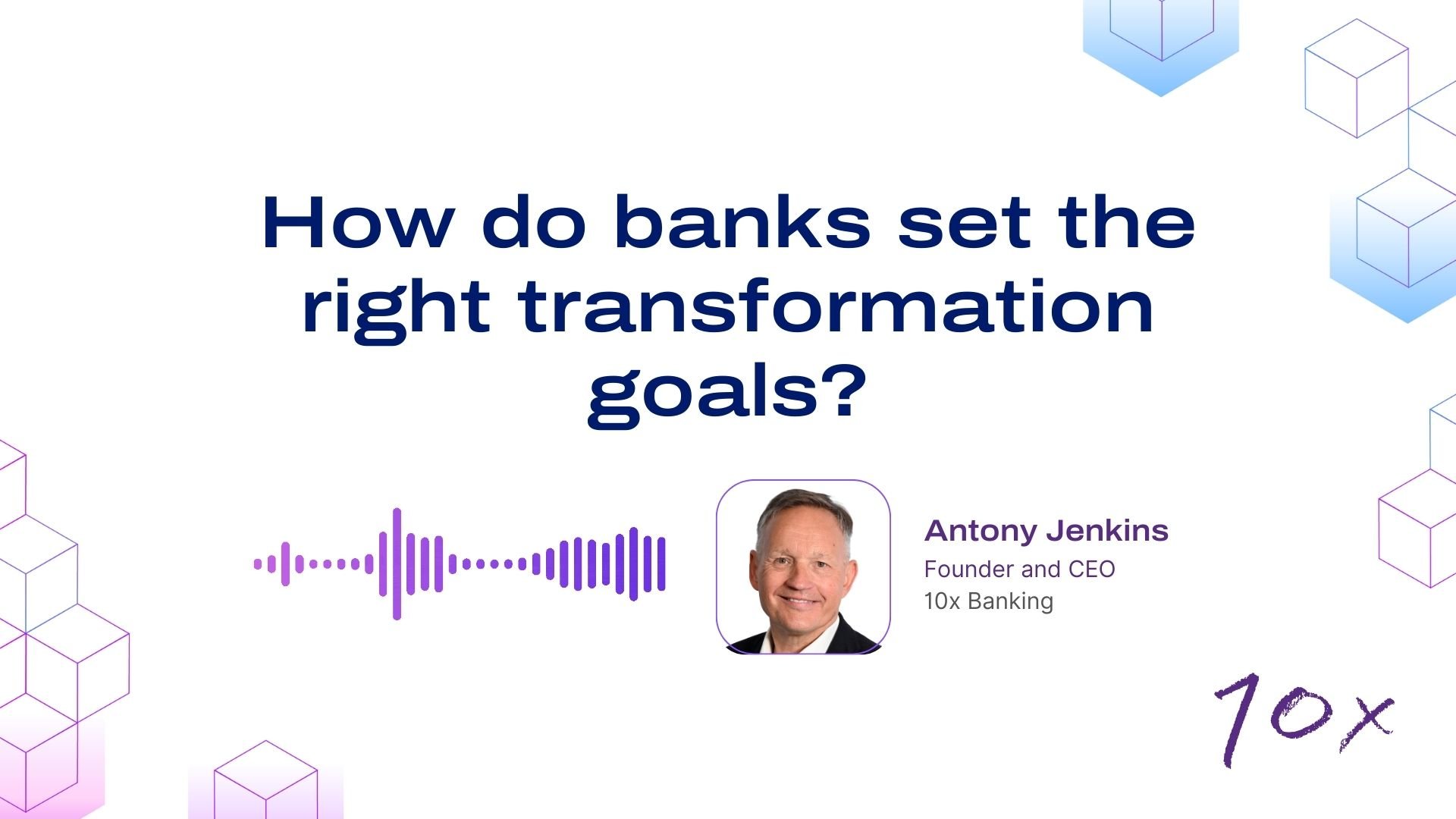Banks are struggling to transform because they are focusing on innovation rather than transformation. The difference, Antony Jenkins explains, is the step change in improvement that transformation brings to banking customers.
Innovation is a linear series of marginal improvements, whereas digital transformation is a nonlinear step change. Banks talk about transformation as a technology issue, whereas I always think about true transformation as starting with the customer and working forwards.
Antony Jenkins Founder and CEO – 10x BankingIn conversation with Antony Jenkins
In the following interview, Antony, former Group CEO of Barclays, explains why many banks aren't on a transformation journey, how challengers have changed the financial services landscape, and how human nature halts progress.
The interview is based on the key findings of our report, global banks and the transformation illusion slowing their progress. Download the report below to learn what's holding banks back from nailing transformation, or use the navigation on the left to skip to specific parts of the interview.
Download the report for more insights
How do banks set the right goals to deliver the right outcomes?
AJ: Yeah, so the first thing is to be very clear about what you're trying to achieve. So sometimes, people mistake transformation for innovation. For me, innovation is a linear series of marginal improvements, whereas transformation is a nonlinear step change in improvements. And banks may talk about digital transformation as a technology-defined issue. Whereas I always think about true transformation as starting with the customer of the bank and working forward.
If you think about internet banking or mobile banking. When those things were added to the bank's repertoire of services, they were valuable to the customer because they no longer had to phone somebody up, go to the branch, or write a check to make a payment. But it was quite a linear progression in terms of the value the bank delivered to the customer. So if you contrast that with what the neobanks have done, they've created an onboarding experience that can be done in two or three minutes on a mobile phone, digitally scanning a passport or a driver's license.
As opposed to the way that would happen in the old world, where somebody would have to make an appointment, go into a branch, take a bunch of documentation, and sit through a 45 to 60-minute interview.
So there's a real difference between innovation and transformation, and there's a difference between technology and true customer impact. And as with any change program in any organization, large or small, this comes down to being very clear about what it is you're trying to achieve, and providing a compelling reason why that matters. All organizations are change resistant. And so you'll get 1000 reasons why we can't do things, you know, ten times better.
And actually, how you overcome that is by providing the rational and emotional reasons for the change journey that you're going to go on.
When I look at our research, it seems to me that lots of people think they are, you know, on a transformation journey, but I suspect very few of them actually are. And when you look at the fact that a very large number of people working in these banks would move to a more digitally-focused bank suggests to me that the people working in them know that a lot of this is just... It's not window dressing, but it's a sort of marginal improvement against what is a significant opportunity and challenge.
A third of banks feel they’ve already achieved their transformation goals. What do you think to this?
AJ: Again, I think it comes back to how you define transformation. If it's just adding a digital app or shutting branches and forcing people to go digital, then I suppose you might convince yourself that you're successfully on that journey. But again, how many banks have created a material improvement in customer experience? A materially better way of using data? A materially lower cost to operate? A material improvement in speed to market for new products?
How many banks have actually done that? I think there are very, very few.
Challengers and neobanks have been around nearly ten years. How has the financial services landscape changed since then?
AJ: There's been a proliferation of places where customers can go to have their financial needs met. And that's not just about the banks. That's also about buy now pay later. It's also about alternative sources of credit. But we've also seen the increasing encroachment of big tech into various aspects of financial services. For example, Apple and Google Pay, which is a fairly basic application: to be able to tap your phone as opposed to your card. But lots of people do it. And the big tech companies make money out of that.
Similarly, look at how Amazon has integrated itself into the payment chain, even for merchants not directly on Amazon. You can still pay with Amazon at checkout. Those examples show how big tech is increasingly creeping into financial services. If you look at Asia, where you see organizations like WeChat intermediating the financial system – all of these things are signs that change is afoot.
Now, there's the old cliche about predictions about the future: we tend to overestimate the short-term impact and underestimate the long-term impact. But we're seeing some fairly profound shifts in customer behavior. So yeah, I think things are changing. And I think they're changing at an increasingly accelerating rate. But it's hard to see that when you look at things at any day-to-day data point.
Banks are losing customers due to slow transformation, but they’re also confident they can beat the competition. Why is this?
AJ: Other industries aren't like financial services. Because financial services are regulated and also very capital-intensive. But if you think about Blockbuster, they were very dismissive of Netflix, they tried to create their own version of Netflix and didn't succeed, but they were the dominant force in what we now call content distribution back in the 90s and early 2000s. And they totally lost that position to Netflix and other streaming services.
Similarly, Kodak invented digital photography, but their mental mindset was all about film. They had a massive market share in the film category, made lots of money out of film, and always thought digital would become a niche occupation. Now, of course, it turns out that film has become the niche. The same with streaming music, where vinyl becomes a niche.
So it's human nature to find it hard to conceive what we understand to be challenged and capable of materially changing. And I think we see that in the banks.
So this always comes back to a discussion of, you know, we tend to think about this problem as a technology problem, but it's not – it's a human being problem, if you like – being able to reframe the direction of travel in the industry, and respond to that in a way that works for an individual bank.
How should banks approach digital transformation?
AJ: So firstly, all the research suggests that it's very hard to transform yourself, which is why banks have sometimes tried to split out the old and the new and to run the new transformation effort completely ring-fenced from the legacy bank. And that can be effective.
But I would say that, at 10x, we've spent seven years trying to solve this problem. And that's all we've done for seven years, with a maniacal focus on it. And because of what we're doing and who we are, we've attracted great talent to solve that problem. It's hard for a bank to try and do this themselves. Because it's one thing they're doing alongside a whole bunch of other things.
Equally, this problem is a common problem across the banks. So there is merit in saying, "Okay, if somebody's built a great solution, why wouldn't we just use that? If we can use the 10x platform to deliver a competitive advantage, why wouldn't we do that?"
Anything can be done with enough time and money. But the risk is that you do what a lot of banks have done with these types of projects over the years, which is spend hundreds of millions, sometimes billions of dollars, and have nothing to show for it at the end of a five or six-year period.
If you can work with somebody like us who has done the heavy lifting, [banks can] do it much more cheaply, much more quickly, and in a much lower-risk fashion.
What motivates Banking Leaders to successfully transform?
AJ: People's motivation is driven by the fear of change versus the fear of not changing. As I say, ten years ago, Bank Executives could convince themselves that they had a very secure position. And that they just did a bit of innovation around the edges, they've continued to be relevant.
And I think that's changed; people are now realizing that they have to change. And if they don't change, they're going to become increasingly irrelevant and pushed down the value chain to a point where they basically lose the customer relationship and become a commodity provider of balance sheet services. And that's not a place that banks want to be.
So it's always that kind of seesaw effect. And if you think about it, from the organizational point of view or a personal point of view, is this a place where a CEO or an Executive team are fearful enough about the future that they're willing to engage in a change journey?
What impact does a successful transformation have on bank employees?
AJ: Yeah, well, it's quite a profound change. Back in November last year, I was talking to a Product Manager for one of the big banks. And he said, "Well, you know, in my old job, I spent all day writing business requirements and chasing the IT department. I don't have to do that anymore. So what am I going to do with my time?"
Whether it's on the Product Management side or the data and analytics side, you actually need to have fewer people. But you need to have better people because you need people whose job is not to say, "Oh yeah, so I've seen my competitor launch this product, now I'm going to write it up and get somebody to build it from me" – their job is to really understand proactively what the customer wants, and be building that.
So 85% of work in banks by data scientists is just cleansing the data. If you take that work away, there are obviously fewer data scientists, but you can point them at real customer problems, not at managing the bureaucracy inside the bank. And that's the fundamental difference. You can run a bank with fewer but better people.
To learn how 10x can help your bank transform for good, get in touch with our team today.



